A Picture of Poverty
![]()
 I recently got back from India where I was with a team of people interviewing children and their families so we can share their stories and photos with you – Compassion sponsors.
I recently got back from India where I was with a team of people interviewing children and their families so we can share their stories and photos with you – Compassion sponsors.
At almost every home we visited, the families were so excited to receive us that they put together mini-feasts. At most homes we were given tea with milk and sugar, and many of them cut fresh coconuts for us, served with straws. I’ve never eaten so many coconuts in my life.
Others would serve us fresh cashews, bananas or pasayam, a sweet cardamom soup. Visiting four families a day, I was more than stuffed and a bit overwhelmed by the generosity. One of these families hadn’t even eaten the day before.
For the interviews, the children typically put on their best clothes, the outfits they got for Christmas from their sponsors.
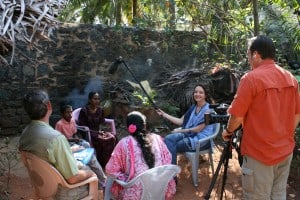 They were so proud to look their best for us and for their photo shoot. This was a very big day for them. The neighbors would lean over the fences and stop in the streets trying to figure out what three white people with a boom mic, camera and video camera were doing in that place. It was often hard to interview over the hoots and comments of the neighbors.
They were so proud to look their best for us and for their photo shoot. This was a very big day for them. The neighbors would lean over the fences and stop in the streets trying to figure out what three white people with a boom mic, camera and video camera were doing in that place. It was often hard to interview over the hoots and comments of the neighbors.
We would take their portrait photos in their best outfits, and as we tried to get photos of them doing their typical chores around their house, we would ask them to put on what they might usually wear. They would come proudly out in their second-best outfit.
This was occasionally somewhat humorous. For example, one very sweet, very incredible 14-year-old girl was trying to pump water in her beautiful new and bejeweled salwar kameez she’d gotten for Christmas. The fuchsia scarf kept falling off her and into her bucket, which I could relate to, having unsuccessfully tried to keep my own scarf on all week.
You can see how it might be difficult to get pictures of what a typical scene might look like, with 20 neighbors shuffling in the background and the families in their Sunday finest, some even with special makeup for the day. And how it might be hard to get pictures displaying the need of the family. These families are excited to be profiled, and of course want to put their best foot forward. What girl wouldn’t want to put her best outfit on, rather than her scrubby clothes, for a very exciting international photo shoot?
I bring this up because I sometimes hear, “Those children in Compassion photos don’t look very needy.” And it’s true. Many of the sponsored children stand out among their neighbors. For one thing, they’ve been taught to comb their hair and brush their teeth at the child development center. They’re also potentially the only ones on the block who received a nice new outfit for Christmas.
But besides these obvious differences, the dignity of the child and the family comes first for Compassion. Chuck, the incredible photographer I was with on this trip, respects the 14-year-old girl’s desire to look her best. He doesn’t ask her to please replace her bright new outfit with the older one with holes in it. He captures her beauty and dignity as she would want to be seen by the world.
Continue Reading ›A Day in Port-au-Prince
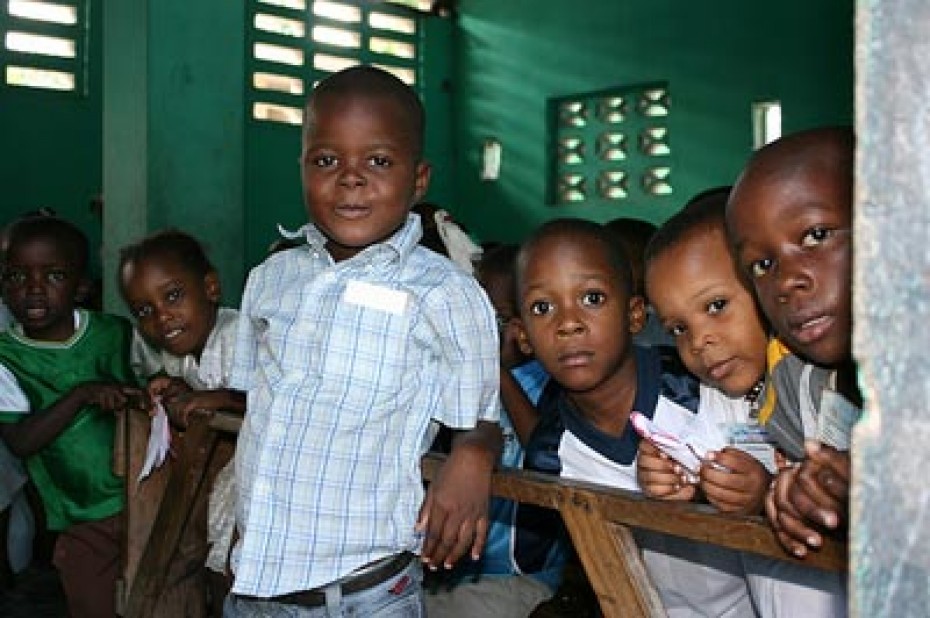
The first thing you notice when you wake up in Port-au-Prince is the smoke. Your eyes sting, and it feels as though you’ve had a smoky cloth held over your mouth all night from the Haitians’ cooking fires.
Continue Reading ›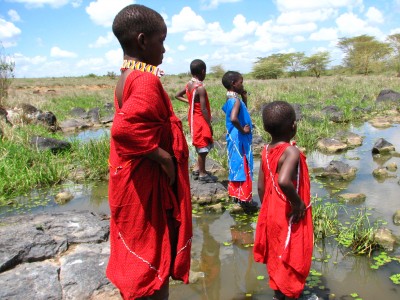
The Stigma of HIV and AIDS
One of the huge challenges facing people living with HIV around the world is not only the physical illness, but the overwhelming stigmatization and discrimination that exists in many countries.
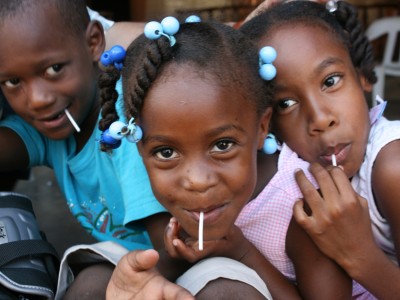
At the Batey
The situation on the batey is as hard as the dirt ground, but there are a few shards of hope gleaming out of it.
Nine Questions With Cesiah Magaña
You asked your questions of Cesiah, field communication specialist in Mexico, and she answered. Take it away, Cesiah.
1. First of all, thank you so much for all you do for the precious children of Mexico! My question is, as you go through each day seeing a multitude of needs in these children’s lives, what do you find yourself praying for most often? (Lindy)
Most of the time, I pray for their hearts. My main prayer is normally that they get to experience the love of Christ. I long for them to know how precious they are to God. I pray that they never give in to the idea of not being worthy or good enough to do anything they dream of.
2. How far do the students travel, on average, to get to the centers and how do they do so? (Walk, bus, etc.) (Beth Ingersoll)
Most of the children registered live very near the churches where they participate in the activities and where they are registered. It is very common for them to walk. As part of the program, Compassion Mexico considers children within 30 minutes walking distance.
In some of the child development centers, it is common to see a few children ride their bicycles to the center, but in those cases it is only a luxury some can afford.
There are other churches where the pastor’s vehicle or the cars owned by the church membership serve to bring children to classes. Every time they drive by the community, children line up to jump in and ride to the church. Many times these are old cars on bumpy and dirt roads, but the fact of being able to ride with the teachers or sparing the hot sun is well worth the tightness.
Finally, there are centers where teachers and staff members split by areas, and they walk the streets around the center to bring children in. Families then trust their children to go with the staff members to church.
Either if children walk by themselves or in big groups or ride their bikes to the projects, they normally wear a special shirt from the project or even uniforms, so it is very nice to watch children come into the centers because they fill the streets with joyful laughter.
New Fall Fashion
It’s fall here in Colorado. The time when the trees and wildflowers turn vibrant yellow and red. The time of brisk blue skies and chilly nights and warm sweaters. The time when I stand in front of my closet and complain, much like a 14-year-old, “I have nothing to wear!”
Recently, I had a chance for a new perspective. Two of my coworkers here at Compassion (one of them being the lovely Becky Tschamler), and I decided to form a wardrobe co-op. Once a month, we get together and swap our clothes, quenching our thirst for new clothes, our own little Sisterhood of Traveling Pants, if you will. Monday was our second swap.
What an eye-opener to have friends see your possessions, which you had been suspiciously eying and disapproving, and proclaim how nice they are and how they’d love to borrow them. It left me feeling a bit silly and quite grateful for what I realize I’ve received. If my fellow coworkers think my wardrobe is nice, what would, say, a worker at a Compassion child development center think of it?
What about you?
You might think shoes and belts are silly, but what’s “your thing” that you sometimes feel a bit deficient in?
- Your car?
- Your home?
- Your kitchen?
- Your movie collection?
- Your out-of-date TV?
Look at it through someone else’s eyes. Through your sponsored child’s eyes. How would they see it?
When I look at my life through someone else’s perspective, a child, a person from another country…and especially God, I realize just how blessed I am and just how much I can bless others. Instead of clamoring for more, more, more, I can be content and focus on what I can do for others. Thank you, God.
7 Questions With David Adhikary
Thanks for asking your questions of David, the Compassion field communication specialist in Bangladesh. Here is the wisdom he has to share with us!
1. First of all, thank you so much for all you do for the precious children of Bangladesh! My question is, as you go through each day seeing a multitude of needs in these children’s lives, what do you find yourself praying for most often? (Lindy)
You are always welcome. Actually, I feel a deep pain when I find myself in a position where I can’t afford to help each of my children to solve their problems.
Every night I pray that at least they could have their dinner and have a sound and peaceful family environment.
2. I would like to know the specifics of how the global food crisis is affecting the people in Bangladesh and how it has affected Compassion’s program there. Have you cut back days that the children meet? Has it made a difference in the type of food that you can afford to serve the children? (Cheryl J)
The price of rice and other food products including lentils, flour, oil, and sugar are increasing continuously from last year.
According to different sources, the cost of the cheapest rice has increased by over 90 percent, and for the better grade rice, it is over 64 percent.
According to the statistics provided by the World Bank and United Nations, the daily income of a lower-level person in Bangladesh is between $1 and $2.
Each family requires at least four pounds of rice each day, which means if they only buy four pounds of the cheapest rice, they have to spend $1.18, which means they have little or no money left to buy vegetables, oil, and other food products.
Compassion Bangladesh hasn’t cut back the number of days that the children meet. Instead, we started an extra day of Compassion program.
Most of the child development centers provided a meal five days a week, but now they are providing a meal six days a week.
Some centers had to reduce their expense for food revenue; they decreased the quantity of food.
After receiving the support of the Global Food Crisis fund, this lack has been filled and children are getting food according to the new, revised menu.
Your support and prayer made it possible.
3. How far do the students travel, on average, to get to the centers, and how do they do so? (walk, bus, etc.) (Beth Ingersoll) (more…)
One Million Prayers
Whenever we pay attention to just the news and not God’s Word, it can get depressing, can’t it?! Headlines with doom-filled words like depression and recession and deflation are daunting.
But I recently got an e-mail from our senior vice president of international program, and he included this verse, which helped me take a long deep breath. (I hold my breath when I get stressed. Bad habit.)
“Do not be anxious about anything, but in everything, by prayer and petition, with thanksgiving, present your requests to God. And the peace of God, which transcends all understanding, will guard your hearts and your minds in Christ Jesus.” (NIV)
The peace of God. Exhale.
Which transcends all understanding (even that of economic forecasters). Inhale.
Will guard your hearts and your minds in Christ Jesus. Exhale.
We are guarded, we are protected by God. We don’t know what will happen in this world or with this economy, but we do know that God has us in his hands. And as David Dahlin reminded us, we have the prayers of a million children surrounding us. All our church partners around the world and all Compassion-assisted children have been asked to pray. To pray for God’s peace, provision, security, direction and wisdom for us. Can you imagine? I’m humbled right down to my marrow.
A colleague from Kenya, Barrack, shared this message recently:
Throughout the chaos of our economic situation, we should not worry because Compassion will be protected. Although Compassion is accustomed to helping the children, during this season it will be the prayers and the tears of the children that will protect Compassion.
Wow. Talk about a cloud of witnesses surrounding us. I can think of no better prayer partner. With these little brothers and sisters, let us throw off everything that hinders us and, holding their small hands, run with perseverance, our eyes fixed on Jesus.
Complementary Interventions With Heidi Partlow
The first thing Heidi Partlow does each morning is check her e-mail. It’s always packed. As Compassion’s complementary interventions manager, she gets all kinds of e-mails each day.
E-mails about how to submit a proposal for a complementary interventions (CIV), e-mails from marketing departments about the particulars of a CIV, e-mails about a disaster that has just occurred.
So her e-mail inbox pretty much dictates her day. After attacking the onslaught of messages each morning, she has a cup of tea at 10 o’clock.
Then she spends a lot of time running around, especially during a week where there has been a crisis, like with the recent hurricanes, getting approvals for funds to be distributed.
But she slowed down enough to give us a peek into CIV and her world. (more…)
Ask the Field: Bangladesh and Mexico
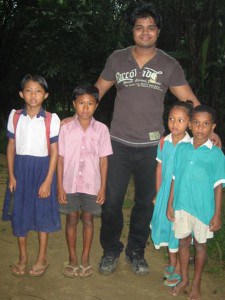 Remember Kamrul, the cycle van driver from Bangladesh you helped buy a cycle van for? Well, David Adhikary is the fine field communication specialist in Bangladesh who reported that story for us. That was one of his first assignments — he just started at Compassion Bangladesh in January. What a nice welcome you gave him!
Remember Kamrul, the cycle van driver from Bangladesh you helped buy a cycle van for? Well, David Adhikary is the fine field communication specialist in Bangladesh who reported that story for us. That was one of his first assignments — he just started at Compassion Bangladesh in January. What a nice welcome you gave him!
Now it’s your turn to ask David about his experiences as a Compassion employee, visiting precious sponsored children, and anything else you’re wondering about Bangladesh.
I’ll tell you a bit about him first. He just finished his electrical engineering degree in December of 2007 when he decided that he wanted to serve the Lord by working with Compassion’s ministry. (An engineer and a writer — talented guy!) He loves English and Bengali literature and is a big sports fan too.
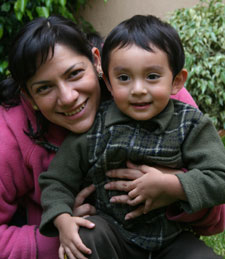 Remember when Chris went to Mexico? He got to meet Cesiah Magaña, who has been working with Compassion Mexico for seven years. She says the seven years have been wonderful — filled with blessings and challenges.
Remember when Chris went to Mexico? He got to meet Cesiah Magaña, who has been working with Compassion Mexico for seven years. She says the seven years have been wonderful — filled with blessings and challenges.
She currently works as the communication specialist, is married and has a precious 2 1/2-year-old son, Jair. She loves driving with her family to the towns around Mexico City, seeing their handicrafts and hearing their stories.
So it’s time to ask your questions of Cesiah and David. I’ll choose ten questions for each of them to answer.
A Field Perspective on Sponsor Trips
Wanna peek into my e-mail inbox?
I have the great pleasure of “talking” (read: e-mailing) each day with some of our great staff around the world. They always challenge me with their perspective.
I’ve been reading along with all the posts and comments about visiting your sponsored child, as I weigh the decision of when to make a trip. (I just happen to sponsor children in two of the most expensive countries to visit!)
This e-mail from Samuel Llanes, our field communication specialist in Guatemala, about his recent experience accompanying a sponsor trip gave me a new perspective on sponsor visits.

Hi Amber,
I want to share with you about what I learned in this sponsor trip we had this summer.
Commitment
I knew the kind of heart a sponsor is supposed to have but NEVER had the experience of “experiencing” it first hand. It was amazing to see and feel the kind of heart they have and how humble they are. And not just them, but even their family! Some of the sponsors came with their entire family and it was so awesome seeing how their kids were so “into” everything! Some of those kids started passing around a plastic bag to collect food to give later to some of the students at the center. For me, it was really amazing. Also, there were some “advocates” there. I had never had the chance to see one of them, but I saw how a heart like theirs really is! 🙂
Tenderness
I saw some of them who met their sponsored children for the first, second or third time. They were so happy (they were even crying!) when they saw them! For me, it was a very touching thing to witness because I could see and prove their commitment toward our fellow sponsored children! It really touched my heart, and those people are a real blessing to me!
A Genuine Heart for the Poor and Compassion International’s Help
I know that the American culture can sometimes be seen as a cold and individualistic culture, but this trip taught me that not everybody is like that. All the sponsors had an utterly different way of treating people (and even me! Hehe!) and they broke indeed a lot of paradigms I had about the American culture. I never saw hearts like those EVER in my life, and I was completely touched by it.
Love
Seeing how humble their hearts and spirits were for the children it’s something indescribable! I could see God’s love showed there and I couldn’t believe it. It was like they were their very own children!
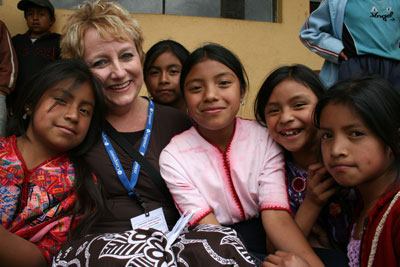
Sam
10 Questions With Ephraim Lindor
Thank you to all of you who submitted questions for Ephraim, my esteemed colleague in Haiti! As you all were curious cats and asked more than 10 questions, I picked 10 that I thought were representative of all the questions.
As I mentioned before, Ephraim has got a lot of perseverance. Check out the Compassion Haiti staff photo from 15 years ago. He’s one of only two staff members still remaining.
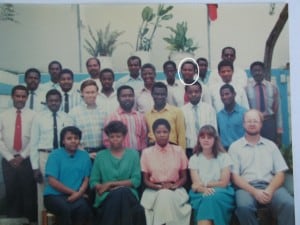
Haiti is economically considered one of the poorest countries of this hemisphere. However, this country is also unique in its natural and culturally diverse resources.
The Haitian is born with the ability to make the most beautiful artwork in the world. No matter the social class he is issued, the Haitian is capable to transform the simplest raw materials into the most enjoyable items. The Haitian paintings are of the greatest imagination, along with our sculpture in wood, steel, or stone.
Although most of its natural resources are unexploited, Haiti is one of the countries with the most beautiful beaches in the Caribbean.
Besides all of its artistic ability, most of the educated Haitians speak up to four languages: Creole (native language), French (official), English, and Spanish with proficiency.
2. I would love to hear your favorite story of children in your programs whose lives were really turned around by being part of Compassion. (Amy)
There are so many success stories that I could share but there this one that is unique to me. It is about a boy named Zaccalot. (more…)


